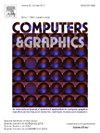LineDrawer: Stroke-level process reconstruction of complex line art based on human perception
IF 2.8
4区 计算机科学
Q2 COMPUTER SCIENCE, SOFTWARE ENGINEERING
引用次数: 0
Abstract
Line art is a fundamental yet powerful form of artistic expression. In this paper, we introduce a novel task aimed at enhancing novice understanding of reproducibility in line drawings: reconstructing the stroke-by-stroke drawing process from complex line art. This task poses substantial challenges, as it requires resolving stroke ambiguity, variations in stroke thickness, and stroke overlapping. To address these issues, we propose a hierarchical framework that emulates human drawing behavior, comprising three stages: (1) high-level generation of global semantic stroke order, (2) mid-level optimization of human drawing mechanics, and (3) low-level perceptual stroke rendering. Drawing inspiration from the human tendency to conceptualize the overall structure before refining local details, we first extract keyframes of the drawing sequence that guide global ordering using a diffusion-based model. Simultaneously, based on the assumption that humans can infer strokes from any cue point in a line drawing, we train a stroke renderer to extract variable-width sub-strokes at the pixel level. Lastly, we formulate a set of equations to model human drawing dynamics, enabling more detailed inference of stroke composition and sequencing within the identified keyframes. This framework effectively integrates high-level semantic understanding with low-level stroke reconstruction, facilitating stroke-level process recovery in complex line drawings. Extensive experiments and user studies demonstrate that our method produces relatively natural and coherent drawing process animations for high-quality line art.

LineDrawer:基于人类感知的复杂线条艺术的笔画级过程重建
线条艺术是一种基本而有力的艺术表现形式。在本文中,我们介绍了一项新的任务,旨在提高新手对线条绘画再现性的理解:从复杂的线条艺术中重建一笔一笔的绘画过程。这项任务提出了实质性的挑战,因为需要解决笔画模糊、笔画厚度变化和笔画重叠问题。为了解决这些问题,我们提出了一个模拟人类绘画行为的分层框架,包括三个阶段:(1)高级生成全局语义笔画顺序,(2)中级优化人类绘画机制,(3)低级感知笔画渲染。在提炼局部细节之前,我们从人类倾向于概念化整体结构的趋势中获得灵感,我们首先提取了使用基于扩散的模型指导全局排序的绘图序列的关键帧。同时,基于人类可以从线条绘制中的任何线索点推断笔画的假设,我们训练笔画渲染器在像素级提取可变宽度的子笔画。最后,我们制定了一组方程来模拟人类绘画动力学,从而可以在确定的关键帧内更详细地推断笔画组成和顺序。该框架有效地将高级语义理解与低级笔画重建相结合,促进了复杂线条图中笔画级过程的恢复。大量的实验和用户研究表明,我们的方法可以为高质量的线条艺术产生相对自然和连贯的绘图过程动画。
本文章由计算机程序翻译,如有差异,请以英文原文为准。
求助全文
约1分钟内获得全文
求助全文
来源期刊

Computers & Graphics-Uk
工程技术-计算机:软件工程
CiteScore
5.30
自引率
12.00%
发文量
173
审稿时长
38 days
期刊介绍:
Computers & Graphics is dedicated to disseminate information on research and applications of computer graphics (CG) techniques. The journal encourages articles on:
1. Research and applications of interactive computer graphics. We are particularly interested in novel interaction techniques and applications of CG to problem domains.
2. State-of-the-art papers on late-breaking, cutting-edge research on CG.
3. Information on innovative uses of graphics principles and technologies.
4. Tutorial papers on both teaching CG principles and innovative uses of CG in education.
 求助内容:
求助内容: 应助结果提醒方式:
应助结果提醒方式:


